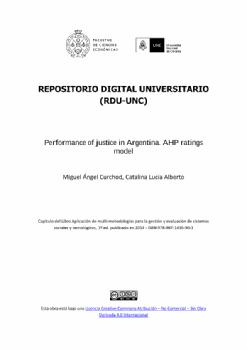| dc.contributor.author | Curchod, Miguel Ángel | |
| dc.contributor.author | Alberto, Catalina Lucía | |
| dc.date.accessioned | 2022-07-20T17:39:30Z | |
| dc.date.available | 2022-07-20T17:39:30Z | |
| dc.date.issued | 2014 | |
| dc.identifier.isbn | 978-987-1436-90-3 | |
| dc.identifier.uri | http://hdl.handle.net/11086/27377 | |
| dc.description.abstract | The aim of this study is a comprehensive assessment of the management of the different production units of the Ordinary Justice Administration in Argentina based on different attributes and criteria underpinning production. This assessment will further allow us to use a ranking method to appraise of the performance of the units analyzed. This study aims to take a first step towards obtaining a comprehensive picture of the system to serve as guidance to look into other specific aspects in subsequent studies. For this reason, the analysis is carried out in a general way, without either specifying the different matters dealt with the ordinary justice system: criminal, civil, administrative, labor or commercial, nor making a distinction of organs or bodies. For this evaluation, we propose to use the discrete multicriteria decision method (DMD): Analytic Hierarchy Process (AHP) and specifically within this methodology, the ratings or scoring model. This approach arises from considering the Data Envelopment Analysis (DEA) as a particular case of DMD techniques (Mackeprang Pérez, 2003). This perspective equates: a) the minimum criteria to inputs, b) the maximum criteria to outputs c) and the alternatives to the decision making units (DMU). The international literature accessed makes abundant reference to the analysis and evaluation of efficiency in Justice Courts by means of quantitative techniques, mainly in places like the USA, Canada and European countries. This is not as common in Latin American countries. The works consulted show that the technique generally used in similar cases is Data 36 Envelopment Analysis, although we found some analysis which used parametric models (Pedraja, F. et al. 1995). It is also important that, regardless of the techniques used (mathematical programming, parametric methods or multi-criteria decision analysis), the inputs and outputs defined do not differ greatly. On the other hand, it is important to note that most of the studies carried out the analysis starting from the particular instances, ie focusing the analysis on a specific area (criminal, labor, civil, etc.) or on a particular jurisdiction or on a given instance. It is stated on the other hand, the basic text of this chapter has been presented in full paper character in the Fourth International Workshop on
Knowledge Discovery, Knowledge Management and Decision Support - Eureka-2013-, held in Mazatlan, Mexico. At that time he underwent refereed and accepted by the scientific committee of the event. | es |
| dc.description.uri | http://hdl.handle.net/11086/1336 | |
| dc.format.medium | Impreso; Electrónico y/o Digital | |
| dc.language.iso | eng | es |
| dc.rights | Licencia Creative Commons Atribución – No Comercial – Sin Obra Derivada 4.0 Internacional | * |
| dc.rights.uri | http://creativecommons.org/licenses/by-nc-nd/4.0/ | * |
| dc.subject | Justice | es |
| dc.subject | Evaluation | es |
| dc.subject | Analytic Hierarchy Process (AHP) | es |
| dc.subject | Ratings | es |
| dc.title | Performance of justice in Argentina. AHP ratings model | es |
| dc.type | bookPart | es |
| dc.description.fil | Fil: Curchod, Miguel Ángel. Universidad Nacional de Córdoba. Facultad de Ciencias Económicas; Argentina. | es |
| dc.description.fil | Fil: Alberto, Catalina Lucía. Universidad Nacional de Córdoba. Facultad de Ciencias Económicas; Argentina. | es |
| dc.journal.referato | Con referato | |
| dc.description.field | Ciencias Sociales Interdisciplinarias | |
| dc.book.city | Córdoba | |
| dc.book.country | Argentina | |
| dc.book.editorial | Asociación Cooperadora FCE UNC | |
| dc.book.firstpage | 35 | |
| dc.book.lastpage | 45 | |
| dc.book.pages | 311 | |
| dc.book.role | Autor | |
| dc.book.tome | 2 | |
| dc.book.title | Aplicación de Multi-Metodologías para la Gestión y Evaluación de Sistemas Sociales y Tecnológicos. Tomo II | es |





